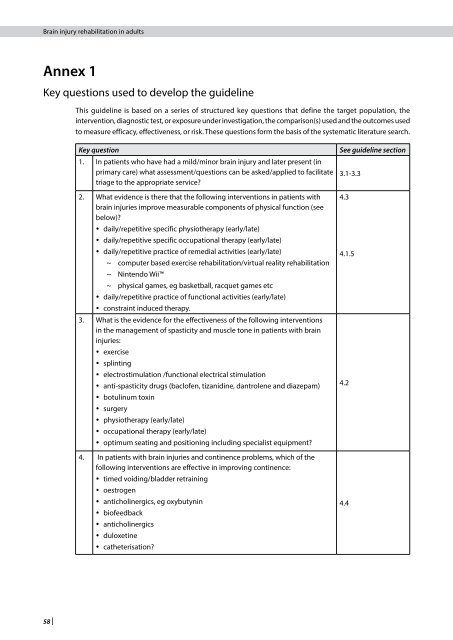sign130
sign130
sign130
Create successful ePaper yourself
Turn your PDF publications into a flip-book with our unique Google optimized e-Paper software.
Brain injury rehabilitation in adults<br />
Annex 1<br />
key questions used to develop the guideline<br />
58 |<br />
This guideline is based on a series of structured key questions that define the target population, the<br />
intervention, diagnostic test, or exposure under investigation, the comparison(s) used and the outcomes used<br />
to measure efficacy, effectiveness, or risk. These questions form the basis of the systematic literature search.<br />
Key question See guideline section<br />
1. In patients who have had a mild/minor brain injury and later present (in<br />
primary care) what assessment/questions can be asked/applied to facilitate<br />
triage to the appropriate service?<br />
3.1-3.3<br />
2. What evidence is there that the following interventions in patients with<br />
brain injuries improve measurable components of physical function (see<br />
below)?<br />
y daily/repetitive specific physiotherapy (early/late)<br />
y daily/repetitive specific occupational therapy (early/late)<br />
y daily/repetitive practice of remedial activities (early/late)<br />
~ computer based exercise rehabilitation/virtual reality rehabilitation<br />
~ Nintendo Wii<br />
~ physical games, eg basketball, racquet games etc<br />
y daily/repetitive practice of functional activities (early/late)<br />
y constraint induced therapy.<br />
3. What is the evidence for the effectiveness of the following interventions<br />
in the management of spasticity and muscle tone in patients with brain<br />
injuries:<br />
y exercise<br />
y splinting<br />
y electrostimulation /functional electrical stimulation<br />
y anti-spasticity drugs (baclofen, tizanidine, dantrolene and diazepam)<br />
y botulinum toxin<br />
y surgery<br />
y physiotherapy (early/late)<br />
y occupational therapy (early/late)<br />
y optimum seating and positioning including specialist equipment?<br />
4. In patients with brain injuries and continence problems, which of the<br />
following interventions are effective in improving continence:<br />
y timed voiding/bladder retraining<br />
y oestrogen<br />
y anticholinergics, eg oxybutynin<br />
y biofeedback<br />
y anticholinergics<br />
y duloxetine<br />
y catheterisation?<br />
4.3<br />
4.1.5<br />
4.2<br />
4.4


